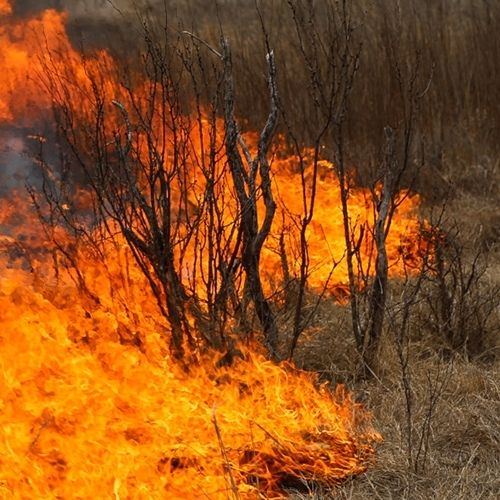Prescribed burn kit launch aims at education, advocacy
Stakeholder suggestion leads to publication
One of the biggest obstacles for landowners and burn managers advocating for prescribed burns is the need to educate communities and county officials about what exactly a prescribed burn entails, the safety protocols involved and the ultimate benefits for the land.

Experts from the Texas A&M AgriLife Extension Service, rangeland and prescribed burn scientists and specialists, and stakeholders all came together to create a communication kit to make it easier for landowners to educate the public and advocate for prescribed burns.
Anyone may now download the Prescribed Burn Kit they developed for free at https://tx.ag/PrescribeBurnCommKit. Hard copies are also available at select AgriLife Extension county offices.
Burn kit inspiration
The inspiration for the Prescribed Burn Kit initially came from a stakeholder who attended a virtual Texas A&M AgriLife Research workshop on prescribed fire held last year.
“We had originally planned on having workshops across the Great Plains region, but that all changed with Covid-19,” said Morgan Treadwell, Ph.D., AgriLife Extension rangeland specialist, San Angelo. “Instead, we had one online workshop that attracted over 500 participants, not only from Texas but across the U.S., and we even had some international attendees.”
Mike Watson was one of those participants. Watson had recently retired outside of Lampasas and had bought land that he described as being neglected and in poor shape for decades.
“My wife and I began looking into ways to restore our land,” Watson said, “And a big part of that is clearing brush. We started doing our research, which led us to our local burn association, Burnet- Lampasas, a chapter of the Edwards Plateau Prescribed Burn Association. That, in turn, led me to AgriLife Extension’s educational resources on prescribed burns.”
He realized if there was a way to concisely summarize the hours of expert advice and graduate research he had consumed during the workshop, many other landowners and burn associations could benefit from it.
After the online event, Watson reached out to Treadwell to see if there was something landowners could use to assist them in their advocacy and education efforts. Five peer-reviewed publications came out of the workshop. While he said the information in the seminar was great, he needed something concise and condensed that burn association members could use.
“The virtual seminar was heavy on qualitative research, and the studies associated with it by graduate students were fairly dense,” said Treadwell. “In the past, other landowners had come to me also looking for information they could give to a newly elected county or government official who wasn’t familiar with prescribed burns, so that confirmed the need.”
Creating the prescribed fire kit
After some research, Treadwell and some other members of the Great Plains Fire Science Exchange, a federal agency funded by the Department of Interior Bureau of Land Management to support prescribed fires within the Great Plains states, determined that a communication kit should be created to fill the void.
“We needed to create something that was landowner-friendly and landowner-driven,” Treadwell said. “We needed to make a consolidated report that was essentially a one-stop-shop for prescribed burn information.”
The five-member committee that created the Prescribed Burn Kit included Treadwell; Watson; Carolyn Baldwin, Ph.D., primary investigator and program coordinator, and Lori Bammerlin, communications and outreach coordinator, both with Great Plains Fire Science Exchange, Kansas State University; and Carissa Wonkka, Ph.D., U.S. Department of Agriculture-Agricultural Research Service, Northern Plains Agriculture Research Lab, Montana.
“What we all came together to ultimately develop was an excellent way to communicate the science of prescribed burns to burn managers and prescribed burn associations all across country,” said Baldwin.
Although the eight-page kit was tailored for prescribed burns in the Great Plains region, it can be used by any burn association, burn manager or landowner since it includes options to customize to a region’s resources.
Baldwin said the kit includes talking points, communication methods, suggestions on how to effectively advocate, a sample burn notification letter, as well as links to videos and additional useful information.
Education
The committee saw the kit as something burn association members could utilize when speaking with local government officials.
“We wanted members to have the best possible outcome when approaching officials about prescribed burns,” Baldwin said. “We wanted members to be able to present factual information that would provide an accurate understanding of the many benefits of prescribed burning including range management, livestock production, woody plant control and the benefits to nature and wildlife habitat.”
She said one of the best ways to communicate risk management and the benefits of fire is to utilize the kit and invite commissioners and judges to participate in a prescribed burn themselves. By sharing the prescribed burn plan with them, they can better understand how much planning goes into a prescribed burn.
“We want the support of our county, neighbors, volunteer fire department and officials when we do prescribed burns,” Watson said. “This provides us with a tool kit to present information on prescribed burns. These burns are key not only to restoring land but reducing burn loads, which better protects land from wildfires.”


